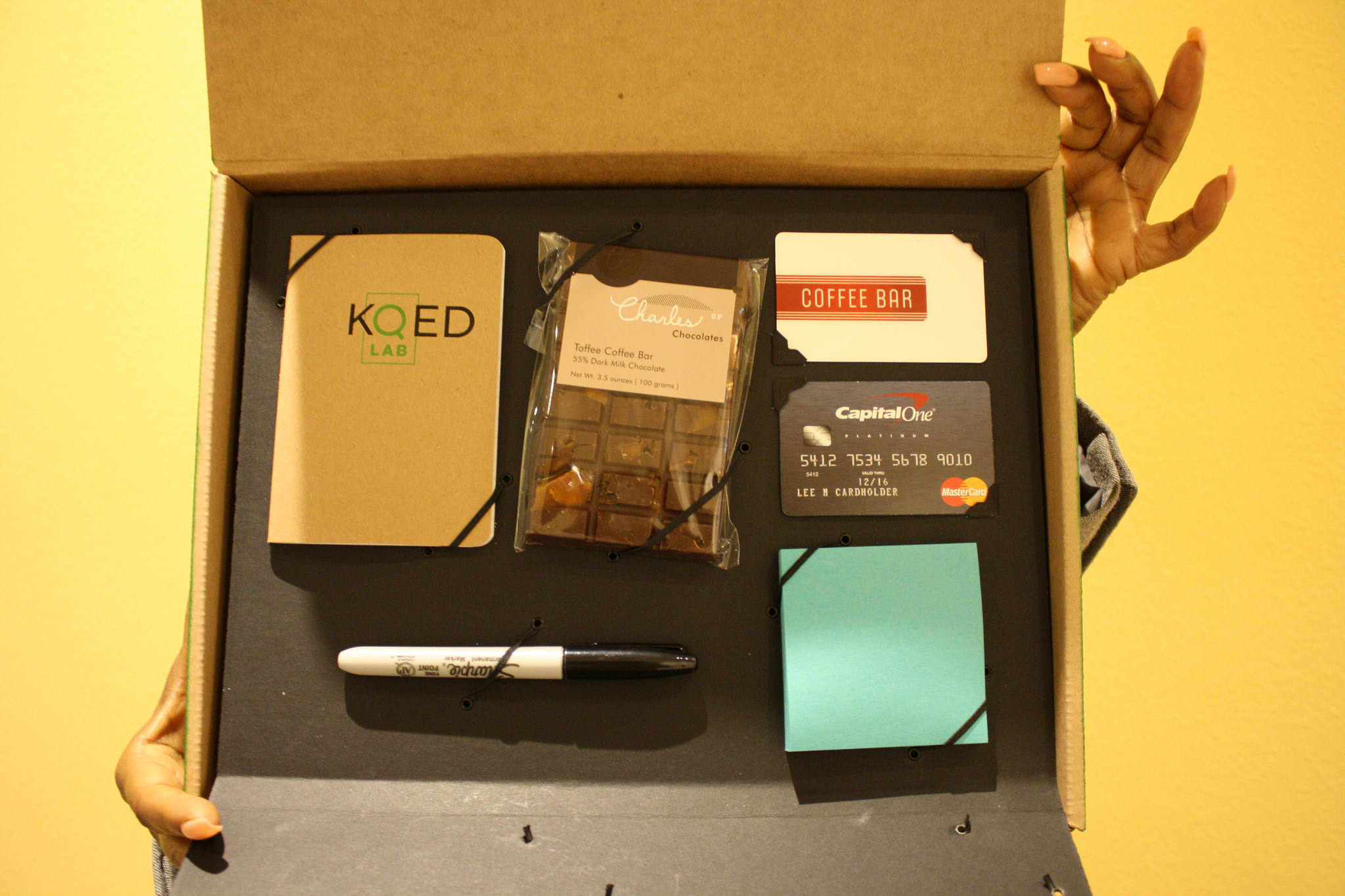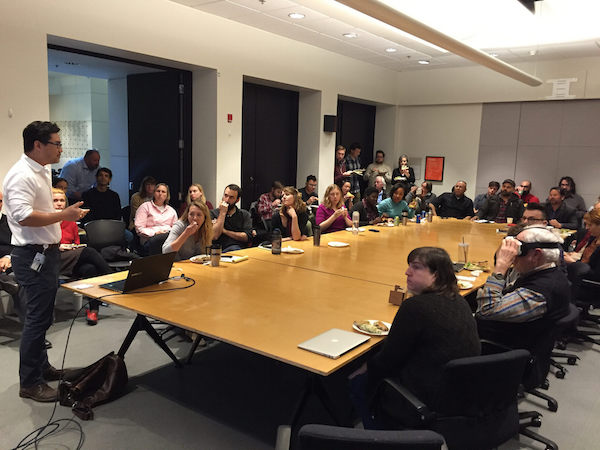
Chloe Veltman’s day job is senior arts editor for the San Francisco public media outlet KQED. But for eight consecutive Fridays last winter, she took a break from reporting to become an entrepreneur of sorts.
Veltman was a participant in the inaugural class of KQED Lab, a design-thinking bootcamp the station launched earlier this year to develop new products and initiatives related to engagement and retention.
KQED invited staffers from across the station to form teams and apply to participate in the class. More than 40 staffers on 15 teams submitted applications, and five teams were ultimately chosen.
Veltman’s unit developed KQED Field Trips, in which KQED staffers and experts take public groups on adventures in the Bay Area. Other projects focused on 360-degree video and monetization of the station’s vast archives.Over the course of eight weeks, the participants went through a process modeled after media startup accelerator Matter’s 20-week program. (KQED was one of Matter’s founding partners.)

“The goal is to provide the time, space, and process for staff to test and prototype their ideas,” Tim Olson, KQED’s VP for digital media and education, said. “A lot of the Lab program is modeled on what we’ve learned from Matter.”
The program began with a two-and-a-half-day boot camp that introduced the participants to design thinking and the accelerator process. Each team received a cardboard box called a Kickbox, filled with a notebook, sticky notes, a Sharpie, chocolate, a coffee shop gift card, and a $1,000 prepaid debit card.

“We’re investing in you and the ability to move quickly,” Olson said. “If the 360-video team is like, ‘Gosh, we need a camera,’ they can turn around and buy one just like that.”
At the last session, the teams gave seven-minute presentations on their projects to the entire station’s staff.

For KQED Field Trips, Veltman and her team members spent their Fridays brainstorming, interviewing potential participants, actually planning and running a test field trip with a KQED reporter, and preparing for their presentation.
“It felt like we were in an endurance test,” Veltman said, noting that her work on the project ended up stretching beyond the time set aside for the Lab on Fridays.
The KQED Demo Day took place in early March, and while some of the projects ended there, others are being adapted and moving forward. One group, inspired by the newsletter The Skimm, examined whether the station could reach younger audiences by changing the tone of its coverage. That project is transforming into an email welcome series that KQED will pilot for leads it gets from online platforms.The field trips are also continuing. So far, the team has organized events like a wine tasting and crostini building competition at a local Italian restaurant (a smoked duck breast crostini won) and a guided tour of San Francisco’s recently renovated Museum of Modern Art.
Veltman said the aim of the field trip project was to find new ways to engage in conversation with KQED’s listeners.
“There’s something about small groups versus having an event for 600 people,” Veltman said. “With just 25 people, you reach them in a deeper, more intimate way. There’s a difference between sticking some of our reporters and editors up on stage, and doing something that’s much more ‘get up off your tush and join us, we’re going on an adventure.’ It has a different effect.”
Veltman had been kicking around the idea for a program like KQED Field Trips for a few years, but said she needed the rigor of the Lab program and the support of the station to begin to implement it.
“I’m extremely busy in my job. I don’t have time to run a weekly field trip,” she said. “I needed the backing of KQED to help to systematize it and make it part of the culture here. We’re not there yet, but we’re testing it out and the results so far have been promising.”
Olson worked with KQED executive director and Lab director Colleen Wilson and product manager Jessica Want to launch KQED Lab. At first, they worked on it in addition to their other daily responsibilities; the station subsequently hired a project manager, Umbreen Bhatti, to work specifically on the Lab.
KQED is now figuring out the best way to move the effort forward. There will be a second class early next year, and the focus may be narrowed to a more specific subject area.
KQED also has other innovation efforts. The station runs “Brain Food” lunchtime sessions once or twice a month. Speakers from local tech companies are often invited to give an overview of their products or services; one recent speaker was the head of VR partnerships at Samsung.

Various departments at the station take part in design-sprint workshops. Recently, the Arts and Food team thought about how to approach online video. That resulted in the creation of Taste This, a web series that launched last month.
The Lab also offers one-day design challenges in which cross-disciplinary teams from across the organization can come together to work on specific projects. “They don’t need a team or a preset idea,” Olson said. “All they need is a Friday that their boss says they can come spend with us.”
KQED runs a separate program, Qvation, for staffers in non-audience-facing departments to improve processes such as HR record keeping and financial documentation.
“Innovation is a word that gets thrown around a lot,” KQED president John Boland told me. “It sounds very exotic, but it’s really pretty simple: It’s changing things for the better. It’s interesting new ideas, processes, or strategies that are going to change the established approach.”
KQED is one of a number of large public media outlets trying to redefine how they make money and reach their audiences. WNYC created WNYC Studios to run its podcasts. Boston’s WBUR created BizLab, a separate unit to experiment with new business models and technologies. Boland said programs like KQED Lab and Qvation are possible because the station is financially healthy and receives support from donors. KQED has even done special fundraising around its innovation programs.KQED Lab is part of the station’s three-year strategic plan, which has the overall goal of growing and deepening its relationship with its audience. KQED has added more than 50 new employees over the past three years as it’s grown its newsroom and added new programs. “Absorbing that number of new people, even in a very uplifting situation where we’re getting a good response from the audience and we’re doing interesting things and trying new things, has been a real challenge,” Boland said.

The station is entering the final year of the current three-year cycle, and is working to define goals for the next three years.
As that process continues, Boland said, the station will continue to use KQED Lab to introduce new technologies, find new ways to interact with listeners and viewers, and work to keep KQED relevant.
“I don’t think some big technological change will drive these next couple of years of strategy,” Boland said. “I don’t expect another smartphone and tablet to come along and disrupt; we’re going to be in this mobile environment for quite awhile. We’re going to be thinking about how we engage and serve the audience better.”